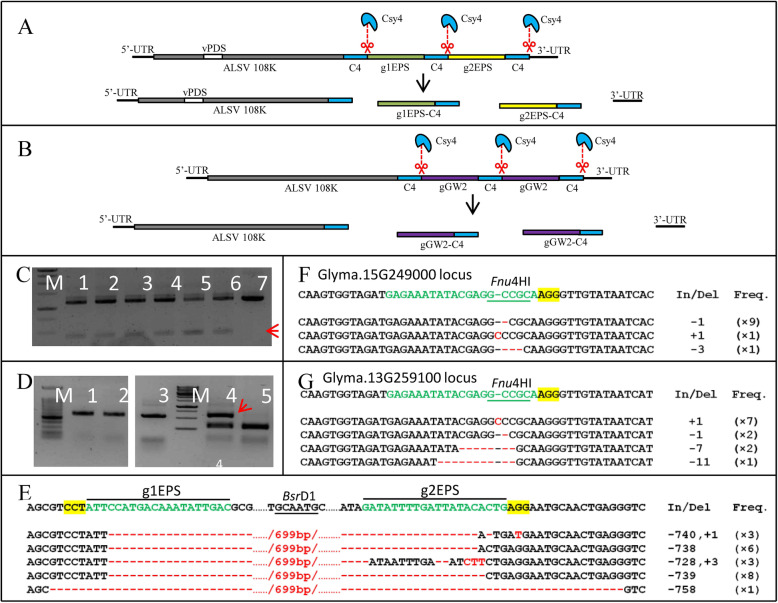Fig. 4.
Multiple targeting with CCAC. (A) Delivery of multiple gRNAs for multiple targeting with CCAC. g1EPS and were replicated and moved along with ALSV virus RNAs, and released from virus RNAs by Csy4 cleavage. (B) Delivery of multiple copies of the same gRNA for single targeting with CCAC. Two copies of were replicated and moved along with ALSV virus RNAs, and released from virus RNAs by Csy4 cleavage. (C) DNA gel with PCR amplicons from EPSPS gene. In lane 1 to 6, the PCR templates the genomic DNA extracted from photobleached leaves which inoculated with CCAC carring g1EPS and g2EPS, and infiltrated by Cas9-Cys4 construct, whereas in lane 7 the template was the photobleached leaves without Cas9-Cys4 construct infiltration as control. The red arrow indicated the long fragment deletion of sequence between g1EPS and g2EPS sites. “M” means DNA marker. Uncropped full-length gels of Figure 4C is shown in Supplementary Figure 10. (D) Genome editing of GW2 paralogs in soybean hairy root. Lane 1 and lane 3 were the PCR products with hairy root transferred by CCAC carring gGW2s and Cas9-Cys4 construct as template, whereas in lane 2 the template was just transferred by CCAC carring gGW2s as control. Lane 4 and lane 5 were the Fnu4HI digested PCR products from lane 1 and lane 2 respectively. The mutation rate (45.3%) was calculated by ImageJ. The red arrow indicated the Fnu4HI-resistant band. Uncropped full-length gels of Figure 4D is shown in Supplementary Figure 11. (E)(F)(G) Sanger sequencing confirms mutations of EPSPS (E) and GW2 paralogs (F)(G). The red arrow indicated bands in C and D were verified by Sanger sequencing. The results showed indels of EPSPS (E) and two GW2 paralogs (F)(G). The wild type sequence is shown at the top respectively

